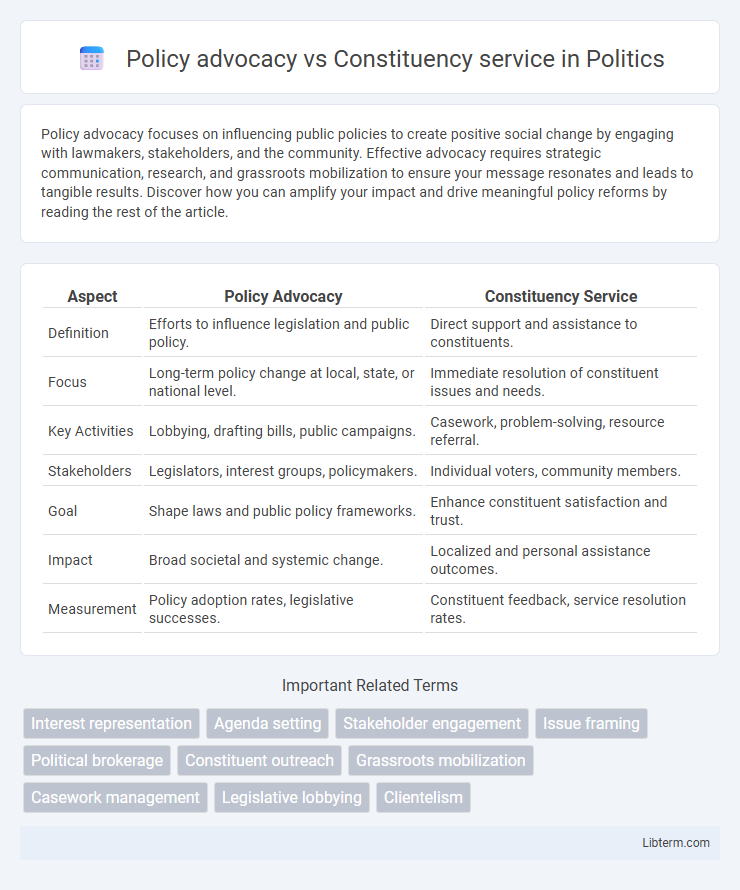Policy advocacy focuses on influencing public policies to create positive social change by engaging with lawmakers, stakeholders, and the community. Effective advocacy requires strategic communication, research, and grassroots mobilization to ensure your message resonates and leads to tangible results. Discover how you can amplify your impact and drive meaningful policy reforms by reading the rest of the article.
Table of Comparison
| Aspect | Policy Advocacy | Constituency Service |
|---|---|---|
| Definition | Efforts to influence legislation and public policy. | Direct support and assistance to constituents. |
| Focus | Long-term policy change at local, state, or national level. | Immediate resolution of constituent issues and needs. |
| Key Activities | Lobbying, drafting bills, public campaigns. | Casework, problem-solving, resource referral. |
| Stakeholders | Legislators, interest groups, policymakers. | Individual voters, community members. |
| Goal | Shape laws and public policy frameworks. | Enhance constituent satisfaction and trust. |
| Impact | Broad societal and systemic change. | Localized and personal assistance outcomes. |
| Measurement | Policy adoption rates, legislative successes. | Constituent feedback, service resolution rates. |
Understanding Policy Advocacy
Policy advocacy involves actively shaping public policy by influencing lawmakers, promoting specific legislation, and mobilizing community support to address systemic issues. It requires deep understanding of political processes, stakeholder interests, and evidence-based strategies to create lasting social change. Effective policy advocacy strengthens democratic participation by giving marginalized groups a voice in decision-making.
Defining Constituency Service
Constituency service involves direct assistance provided by elected officials to their constituents, addressing individual concerns such as navigating government agencies, resolving bureaucratic issues, and securing benefits. Unlike policy advocacy, which targets systemic changes and legislation, constituency service focuses on personalized support to strengthen voter relationships and maintain trust. Effective constituency service enhances political accountability by ensuring constituents' voices are heard and their immediate needs are met.
Key Differences Between Policy Advocacy and Constituency Service
Policy advocacy involves influencing legislation and public policies to address broader societal issues, while constituency service focuses on assisting individual constituents with specific personal or local concerns. Advocacy requires strategic communication, coalition-building, and lobbying efforts targeting government officials, whereas constituency service relies on personalized outreach and problem-solving to meet the immediate needs of community members. The key difference lies in the scope and scale: policy advocacy aims for systemic change, while constituency service prioritizes direct, case-by-case support.
The Role of Elected Officials in Policy Advocacy
Elected officials play a crucial role in policy advocacy by shaping legislative agendas, engaging stakeholders, and influencing public opinion to enact reforms. They leverage their authority to propose, support, or oppose policies that address community needs and promote broader societal goals. Effective policy advocacy requires balancing constituent interests with long-term policy impact, ensuring decisions reflect both immediate concerns and strategic priorities.
The Importance of Constituency Services for Public Trust
Constituency services play a critical role in building and maintaining public trust by directly addressing individual and community needs through personalized support and problem-solving. These services foster stronger connections between elected officials and constituents, enhancing transparency and accountability in governance. Prioritizing constituency services ensures that citizens feel heard and valued, which is essential for democratic engagement and long-term political stability.
Impact of Policy Advocacy on Legislation
Policy advocacy directly influences legislation by mobilizing stakeholders, shaping public opinion, and providing lawmakers with research-based evidence to support policy changes. Effective advocacy campaigns can lead to the introduction, amendment, or repeal of laws that address social, economic, or environmental issues. This impact on legislation ultimately shapes governance frameworks and public resource allocation, distinguishing it from constituency service, which primarily addresses individual or localized concerns.
Constituency Service: Meeting Immediate Community Needs
Constituency service focuses on addressing the immediate needs of community members by providing direct assistance with government services, such as facilitating access to healthcare, education, and social welfare programs. This approach strengthens constituent relationships and enhances public trust by resolving individual concerns promptly. Effective constituency service is essential for politicians to maintain voter support and demonstrate responsiveness at the local level.
Balancing Policy Advocacy and Constituency Service
Balancing policy advocacy and constituency service is crucial for effective political leadership, as it ensures elected officials address broad legislative goals while meeting the specific needs of their local voters. Successful representatives allocate time and resources to championing impactful policies on issues like healthcare and education, while simultaneously providing direct assistance with casework and community engagement. Striking this balance enhances both public trust and policy outcomes by aligning strategic advocacy with responsive constituent support.
Challenges in Prioritizing Advocacy Versus Service
Balancing policy advocacy and constituency service presents significant challenges for elected officials, as advocacy requires long-term strategic efforts to influence legislation while service demands immediate attention to individual or local issues. Limited time and resources often force prioritization decisions that can impact voter satisfaction and policy effectiveness. Navigating these competing demands requires careful management to align constituent needs with broader policy goals without compromising either responsibility.
Future Trends in Policy Advocacy and Constituency Engagement
Future trends in policy advocacy emphasize data-driven decision-making, digital activism, and coalition-building to influence legislative processes more effectively. Constituency service is increasingly leveraging AI-powered platforms to provide personalized communication, streamline case management, and enhance community engagement. Integration of technology and real-time analytics will transform both advocacy and constituency service, fostering more responsive and participatory governance.
Policy advocacy Infographic

 libterm.com
libterm.com